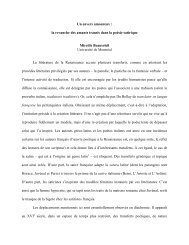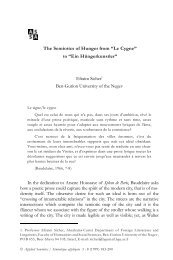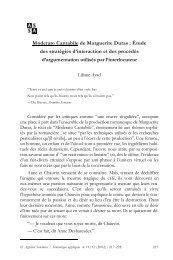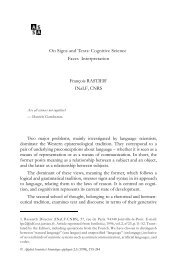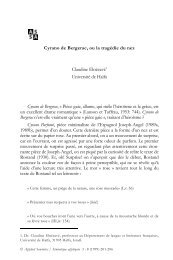“Beannacht libh, cried Miss Ivors” Translating James Joyce: Culture ...
“Beannacht libh, cried Miss Ivors” Translating James Joyce: Culture ...
“Beannacht libh, cried Miss Ivors” Translating James Joyce: Culture ...
Create successful ePaper yourself
Turn your PDF publications into a flip-book with our unique Google optimized e-Paper software.
<strong>Joyce</strong> family while they were living in Paris 4 . She was a dancer, choreographer, and pianist.<br />
Fernandez was quite famous in Paris, her translation is therefore the work of a 1920s Parisian<br />
artist who translated the short story as a friend of the author. These biographical elements show<br />
that neither translator is a professional translator. Aubert was translating as a literary specialist in<br />
1974, whereas Fernandez was translating as an amateur in 1926. This variation in background<br />
and motivations will most likely yield different translation results.<br />
The aim of the comparative analysis is to study the choices two translators, facing an<br />
identical source text, made in regard to CSIs. Thanks to this comparative work, it will be possible<br />
to outline the strategies adopted by translators in the translating process. I will thus begin with an<br />
empirical study (the descriptive comparison of extracts from the source and target texts), which<br />
will lead to conclusions about the translators’ reactions to CSIs. My ultimate goal is therefore to<br />
verify whether there is coincidence between translation theories pertaining to CSIs and the actual<br />
practice of translators, as demonstrated by Aubert and Fernandez. The translations are considered<br />
here as a means to identify the strategies adopted by two translators so as to produce results that<br />
mirror their actual translating practice. By no means am I trying to accomplish the impossible<br />
task of determining which translation is the “best”. Indeed, I will analyze the translators’ choices,<br />
not the actual qualitative value of these choices.<br />
As shown earlier, such a project relates to the relatively young research field known as<br />
Translation Studies. <strong>James</strong> Holmes was one of the first researchers who attempted to define and<br />
organize this discipline. According to him, Translation Studies can be divided into three<br />
branches: descriptive, theoretical and applied 5 . My research is motivated by the reasoning<br />
underlying Descriptive Translation Studies whereby data collected during the empirical studies of<br />
translations allow researchers to articulate theoretical speculations relating to the work of<br />
translators. The descriptive branch hence feeds the theoretical branch. By analyzing translations,<br />
4





